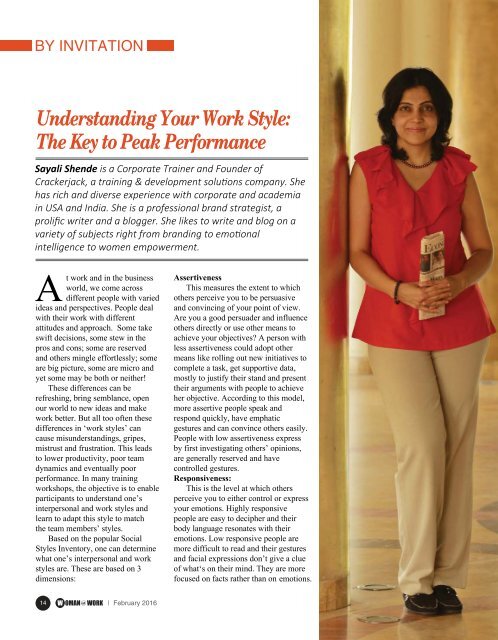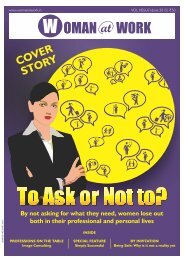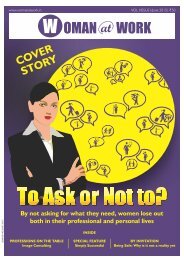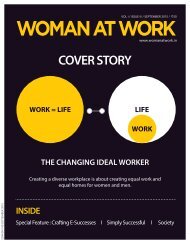February 2016 Woman At Work Digital
Create successful ePaper yourself
Turn your PDF publications into a flip-book with our unique Google optimized e-Paper software.
BY INVITATION<br />
Understanding Your <strong>Work</strong> Style:<br />
The Key to Peak Performance<br />
Sayali Shende is a Corporate Trainer and Founder of<br />
Crackerjack, a training & development solutions company. She<br />
has rich and diverse experience with corporate and academia<br />
in USA and India. She is a professional brand strategist, a<br />
prolific writer and a blogger. She likes to write and blog on a<br />
variety of subjects right from branding to emotional<br />
intelligence to women empowerment.<br />
t work and in the business<br />
world, we come across<br />
different people with varied Aideas and perspectives. People deal<br />
with their work with different<br />
attitudes and approach. Some take<br />
swift decisions, some stew in the<br />
pros and cons; some are reserved<br />
and others mingle effortlessly; some<br />
are big picture, some are micro and<br />
yet some may be both or neither!<br />
These differences can be<br />
refreshing, bring semblance, open<br />
our world to new ideas and make<br />
work better. But all too often these<br />
differences in ‘work styles’ can<br />
cause misunderstandings, gripes,<br />
mistrust and frustration. This leads<br />
to lower productivity, poor team<br />
dynamics and eventually poor<br />
performance. In many training<br />
workshops, the objective is to enable<br />
participants to understand one’s<br />
interpersonal and work styles and<br />
learn to adapt this style to match<br />
the team members’ styles.<br />
Based on the popular Social<br />
Styles Inventory, one can determine<br />
what one’s interpersonal and work<br />
styles are. These are based on 3<br />
dimensions:<br />
Assertiveness<br />
This measures the extent to which<br />
others perceive you to be persuasive<br />
and convincing of your point of view.<br />
Are you a good persuader and influence<br />
others directly or use other means to<br />
achieve your objectives? A person with<br />
less assertiveness could adopt other<br />
means like rolling out new initiatives to<br />
complete a task, get supportive data,<br />
mostly to justify their stand and present<br />
their arguments with people to achieve<br />
her objective. According to this model,<br />
more assertive people speak and<br />
respond quickly, have emphatic<br />
gestures and can convince others easily.<br />
People with low assertiveness express<br />
by first investigating others’ opinions,<br />
are generally reserved and have<br />
controlled gestures.<br />
Responsiveness:<br />
This is the level at which others<br />
perceive you to either control or express<br />
your emotions. Highly responsive<br />
people are easy to decipher and their<br />
body language resonates with their<br />
emotions. Low responsive people are<br />
more difficult to read and their gestures<br />
and facial expressions don’t give a clue<br />
of what‘s on their mind. They are more<br />
focused on facts rather than on emotions.<br />
14<br />
| <strong>February</strong> <strong>2016</strong>














